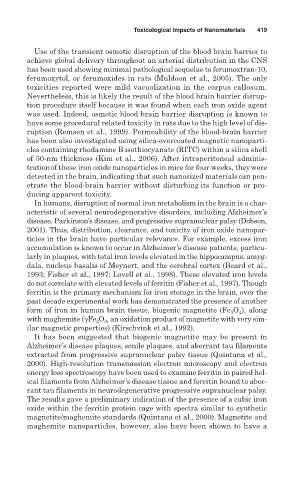Page 439 - Environmental Nanotechnology Applications and Impacts of Nanomaterials
P. 439
Toxicological Impacts of Nanomaterials 419
Use of the transient osmotic disruption of the blood brain barrier to
achieve global delivery throughout an arterial distribution in the CNS
has been used showing minimal pathological sequelae to ferumoxtran-10,
ferumoxytol, or ferumoxides in rats (Muldoon et al., 2005). The only
toxicities reported were mild vacuolization in the corpus callosum.
Nevertheless, this is likely the result of the blood brain barrier disrup-
tion procedure itself because it was found when each iron oxide agent
was used. Indeed, osmotic blood brain barrier disruption is known to
have some procedural related toxicity in rats due to the high level of dis-
ruption (Remsen et al., 1999). Permeability of the blood-brain barrier
has been also investigated using silica-overcoated magnetic nanoparti-
cles containing rhodamine B isothiocyanate (RITC) within a silica shell
of 50-nm thickness (Kim et al., 2006). After intraperitoneal adminis-
trationof these iron oxide nanoparticles in mice for four weeks, theywere
detected in the brain, indicating that such nanosized materialscan pen-
etrate the blood-brain barrier without disturbing its function or pro-
ducing apparent toxicity.
In humans, disruption of normal iron metabolism in the brain is a char-
acteristic of several neurodegenerative disorders, including Alzheimer’s
disease, Parkinson’s disease, and progressive supranuclear palsy (Dobson,
2001). Thus, distribution, clearance, and toxicity of iron oxide nanopar-
ticles in the brain have particular relevance. For example, excess iron
accumulation is known to occur in Alzheimer’s disease patients, particu-
larly in plaques, with total iron levels elevated in the hippocampus, amyg-
dala, nucleus basalis of Meynert, and the cerebral cortex (Beard et al.,
1993; Fisher et al., 1997; Lovell et al., 1998). These elevated iron levels
do not correlate with elevated levels of ferritin (Fisher et al., 1997). Though
ferritin is the primary mechanism for iron storage in the brain, over the
past decade experimental work has demonstrated the presence of another
form of iron in human brain tissue, biogenic magnetite (Fe O ), along
4
3
with maghemite ( Fe O , an oxidation product of magnetite with very sim-
3
2
ilar magnetic properties) (Kirschvink et al., 1992).
It has been suggested that biogenic magnetite may be present in
Alzheimer’s disease plaques, senile plaques, and aberrant tau filaments
extracted from progressive supranuclear palsy tissue (Quintana et al.,
2000). High-resolution transmission electron microscopy and electron
energy loss spectroscopy have been used to examine ferritin in paired hel-
ical filaments from Alzheimer’s disease tissue and ferritin bound to aber-
rant tau filaments in neurodegenerative progressive supranuclear palsy.
The results gave a preliminary indication of the presence of a cubic iron
oxide within the ferritin protein cage with spectra similar to synthetic
magnetite/maghemite standards (Quintana et al., 2000). Magnetite and
maghemite nanoparticles, however, also have been shown to have a

